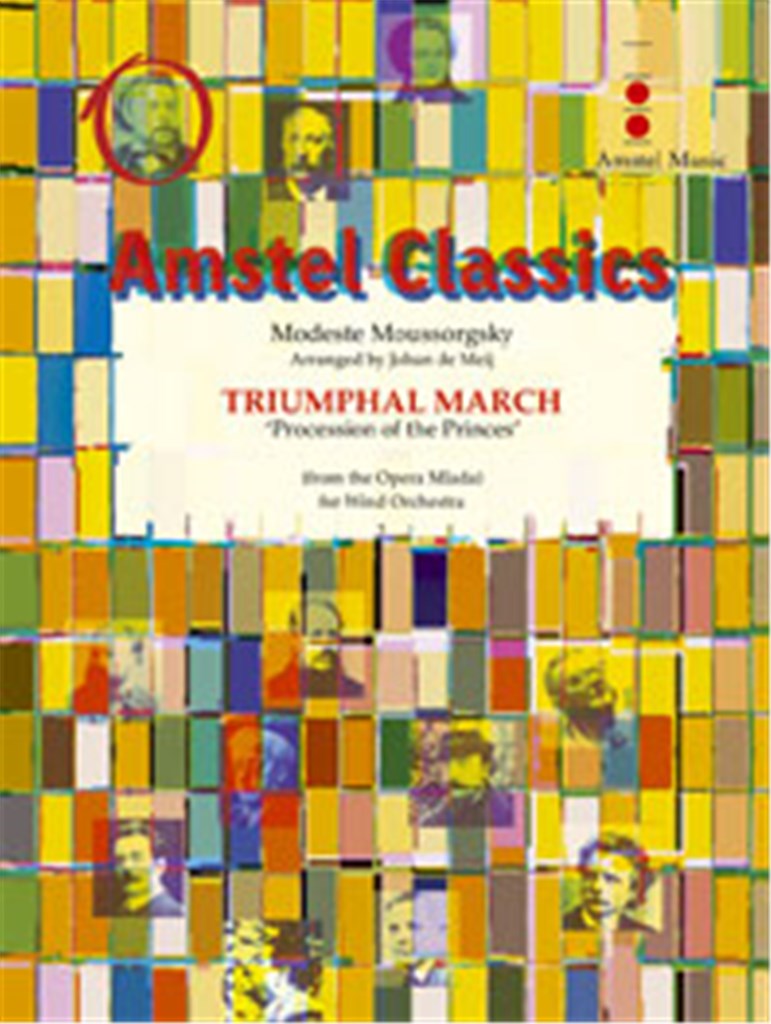Results
-
 £128.00
£128.00Triumphal March (Concert Band - Score and Parts) - Mussorgsky, Modest - De Meij, Johan
The opera-ballet Mlada was an epic project involving six different Russian composers including Mussorgsky, Borodin and Rimsky-Korsakov. Unfortunately the work didn't ever receive a performance however the festive march assumed a life of its own in an orchestration by Rimsky-Korsakov. This has remained one of Mussorgsky's lesser known works however it has been given a new lease of life with this fine arrangement for concert band. Duration: 5.15
Estimated dispatch 7-14 working days
-
 £69.99
£69.99Westminster Prelude (Concert Band - Score and Parts) - Sparke, Philip
London is famous for its history and pageantry. No part of the city epitomises this better than the area known as Westminster. It is home to The Houses of Parliament and Big Ben, Westminster Abbey, Westminster Bridge and numerous other historical sites. It also hosts many annual parliamentary ceremonies that characterise London life. Westminster Prelude aims to capture the mood of life in this famous part of London, both the majesty of its history and the pomp of its ceremonies.Duration: 2:30
Estimated dispatch 7-14 working days
-
 £118.99
£118.99Asteroid Wind Band Set (Score & Parts)
Asteroids and comets have played an important role throughout the history of life on earth. It is quite probable that the dinosaurs have been exterminated by an asteroid's impact in the Gulf of Mexico. Huge tidal waves and fire storms wiped out all life. This is the year 2067 according to the Christian calendar. A collision has just taken place in the asteroid belt between Mars and Jupiter and caused an asteroid to enter the earth's power of gravitation. It is instoppably approaching the blue planet. As its peoples have been fighting each other continuously, they missed the building of a global defence system against dangers coming from space. A scanner records the asteroid and immediately sends a message to the President of the Anglo-American Union. The probability that the asteroid will hit the earth is judged 50% by the experts. Plans are made to shoot the celestial body with rockets live with hydrogen bombs or laser guns in order to throw it off its track, but they fail. The asteroid's size seems to threaten the existence of mankind. Those in the know stare at the night sky in bewilderment. But for the time being, there is still peace on earth.... 0:07:45
Estimated dispatch 7-14 working days
-
 £332.99
£332.99Cantica de Sancto Benedicto Wind Band Set (Score & Parts)
Cantica de Sancto Benedicto is a three-movement work for mixed choir, soprano solo, concert band and organ ad libitum - on Latin lyrics that relate to the life of Saint Benedict. It was commissioned by the city of Norcia in Italy, where Benedict was born. The holy Benedict (480-547) is considered the founder of monastic life within the Roman Catholic Church. His enormous influence is especially owing to his monastic rule, the Regula Benedicti.Jacob de Haan has named the movements of Cantica de Sancto Benedicto after the Holy Trinity: the Father (Gloria Patri), the Son (Gloria Filio) and the Holy Spirit (Gloria Spiritui Sancto). The lyrics of thehymn Gemma Caelestis, (which, like the other texts, were originally used in Gregorian chant) are voiced by the choir. To this purpose, Jacob de Haan composed new, choral-like, homophone music. The sequence Laeta Quies is rendered by the soprano; the verses (divided over the three movements) are alternated with those of Gemma Caelestis. The work closes with an impressive grand finale, in which texts are used from the proprium of the mass in honor of the saint's day of the holy Benedict (11 July). Notes to the conductor: For this cantata, there are various possibilities for the performance. The first involves a performance in which the choir and soprano parts are only accompanied by organ. Such a performance has several advantages: since the band never sounds together with the choir and the soprano, no balance problems occur, and even a performance with a large concert band and a small cantata choir is conceivable. A special layout is also possible - with which you can set up a three-dimensional performance in a church. For example, the choir can sing in the chancel, accompanied by the choir organ; the soprano can stand on the gallery, accompanied by the main organ; and the band can be seated in another part of the church. The choir could also sing from a gallery. With layouts like this, working with two conductors is advisable. Choral parts available separately. 0:28:30
Estimated dispatch 7-14 working days
-
 £112.95
£112.95SYMPHONY No.3 JFK (Concert Band) - Boysen Jr, Andrew
Andrew Boysen's Symphony No. 3 "JFK" honors the life of the great U.S. presidents: John Fitzgerald Kennedy. In one continuous movement, the symphony's sections depicts several aspects of his life: "P.T. 109," "Ask not what your country...," "November 22, 1963," "John-John." In addition to the battery of inventive percussion, the composer calls for a Solo Violin and a Boy Soprano to tell the story.
Estimated dispatch 7-14 working days
-
 £174.99
£174.99The Legend of Flathead Lake Wind Band Set (Score & Parts)
In Scotland, the monster of Loch Ness is a hot issue, but the American state of Montana enjoys a comparable phenomenon going by the name of Montana Nessie. In the western part of this remote state lies Flathead Lake: a lake of 45 kilometres /38 miles in lenght and 24 kilometres /15 miles breath. At several places, its depth exeeds 100 metres.Nessies discovery takes us back to the year 1889, when captain James Kerr aboard the passengership U.S.Grant was startled by a ship unknown to him suddenly approaching his vessel across Flathead Lake. However, it turned out not to be a ship but an undefinable animal of immense size.From that moment onwards, life would never be the same again in and around Flathead Lake.The composer was inspired by the story, and summarized the events into a symphonic poem, but from a surprising angle:that of the monster. The exiting opening allows us to follow the monster in its natural surroundings.The fast follow-up movement depicts Montana Nessie trotting and frolicking about the Montana woods and prairies.From its abode, it thorougly enjoys everything around it. This period abruptly ends in a short climax (Chimes). The solo for cor anglais marks a new period in the monsters life.The presence of people has a paralizing effect and the apprehensive atmosphere of the slow movement may be felt profoundly.The monster observes and mildly teases the ship. Abhor sounds force the ship to a withdrawal.The moving musical continuation depicts the triumphant monster dancing an ironic waltz. The monsters fear and anger at the intrusion of his freedom run through the piece like continuous threads, and develop into the works final theme. 12:00
Estimated dispatch 7-14 working days
-
 £119.60
£119.60Frankenstein - Kelly Bennette
This tone poem entitled Frankenstein is based on the original novel by Mary Shelley (1797-1851). Victor Frankenstein creates life from pieces of many dead bodies. Soon, his monster comes to life. Though very intelligent, the monster has the maturity of a child. In a fit of rage, the monster kills William, Victor's younger brother. The monster finds Victor in The Alps and asks him to make him a mate. Victor makes him a mate, but kills her. The enraged monster tells Victor, "I will be with you on your wedding night." The monster forces his way into the wedding and kills Victor's fiance, Elizabeth. Victor chases the monster all the way to the Arctis where he dies of exhaustion. The monster finds Victor's body and realizes he has nothing to live for and goes away to die.
Estimated dispatch 7-14 working days
-
 £69.99
£69.99Westminster Prelude - Philip Sparke
London is famous for its history and pageantry. No part of the city epitomises this better than the area known as Westminster. It is home to The Houses of Parliament and Big Ben, Westminster Abbey, Westminster Bridge and numerous other historical sites. It also hosts many annual parliamentary ceremonies that characterise London life. Westminster Prelude aims to capture the mood of life in this famous part of London, both the majesty of its history and the pomp of its ceremonies.
Estimated dispatch 7-14 working days
-
 £59.80
£59.80Alte Kameraden - Carl Teike
It is the greatest tragedy in the life of a young composer if he happens to write his most successful piece at the beginning of his musical career. This holds true for Carl Teike, as the unsurpassed success at the beginning of his musical life was his march "Old Comrades". It is a sparkling piece that may well be labeled to be the German "march of marches". Carl Teike was born on Feb. 05, 1864 in Altdamm. After his parents had moved to Stettin, he had early contacts with military music as a youngster. The enthusiasm for this kind of music never left him throughout his life. He began a musical apprenticeship with City Music Director Bttcher in Wollin and already played in the spa orchestra of Bad Misdroy, which Bttcher conducted. Upon completing his apprenticeship, he enlisted as a volunteer in the band of the (5th Wrttemberg) King Karl Grenadiers No. 123 in Ulm. The musical and military environment there proved to be ideal for the ambitious young musician, who hoped to eventually study band music at the University of Music in Berlin. Above all, his military superior, bandmaster Julius Schreck supported young Teike wherever he could. Unfortunately the time in Ulm took a very unhappy turn, as Schreck's successor was extremely resentful towards Teike, and musical support was replaced by sheer harassment. On account of this, Teike retired from the military towards the end of 1889. Short employments in Ravensburg and Ulm evidently did not suit Teike, who was of northern German descent. This is why he applied for the Royal Police Force in Potsdam. Teike was accepted and entered service in 1895. The royal capital of the Hohenzollerns obviously stirred Teike to write a number of brilliant marches. He even became known abroad as the "musical policeman". Unfortunately he contracted a severe pneumonia while on duty, which eventually forced him to retire from the Royal Police Force in Potsdam. On February 01, 1909 he and his family moved to the prosperous provincial city of Landsberg on the Warthe (which is located east of Berlin in present-day Poland). There, Count Clairon d'Haussonville proved to be an understanding superior who paved the way for modest Carl Teike to continue composing, as his creativity had not suffered from this move. The disease which he had caught in Potsdam evidently was more severe than he was inclined to accept. In spring 1922, his state of health became worse, and in May of that year he passed away. Much too early - as many people felt. Teike's marches constitute an enrichment of the German concert march, as he never composed any street marches. Clear structures, musical ingenuity and a multitude of tone colors distinguish his works and shape them into something really new. It is this type of the march in particular that became the bedrock of the universal appeal of the German march. Even today Teike's marches stand unrivaled for musical quality and content - and they never are aggressive. Toward the end of his tour of duty in Ulm, Teike handed a new march to his superior, which, at the time, did not have a title yet. He in turn told Teike to "put it in a stove and burn it". As we know today, this was a classic misappraisal, as Teike subsequently named his march "Old Comrades" in view of his impending retirement. We do not even need to discuss the acceptance the march has met and still meets all over the world, as "Old Comrades" simply always has been a march of universal appeal. In his new arrangement, Siegfried Rundel did not change the essence of Teike's music, he rather sensitively adapted it to modern musical practice and to the instrumentation of the symphonic band on the basis of his deep respect for the works of Carl Teike.
Estimated dispatch 7-14 working days
-
 £77.50
£77.50Polka From The Bartered Bride - Gary E. Parks
Whirling, brightly-clad dancers, brought to life in Smetana's "Polka" from The Bartered Bride, are reanimated in this exhilarating transcription for concert band. The joyful celebration of Bohemian peasant life is evidenced from the development of the principal theme to the dramatic presto at the end. You'll find it hard to stay in your seat! (4:55)
Estimated dispatch 7-14 working days
